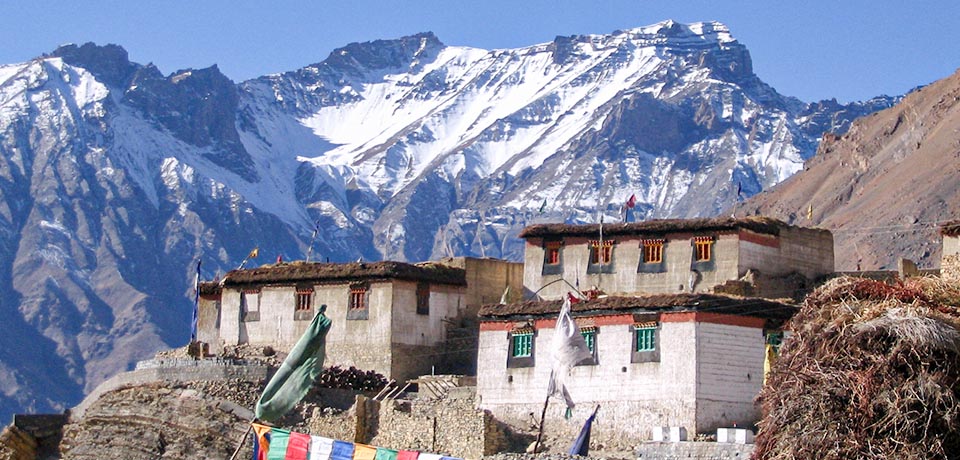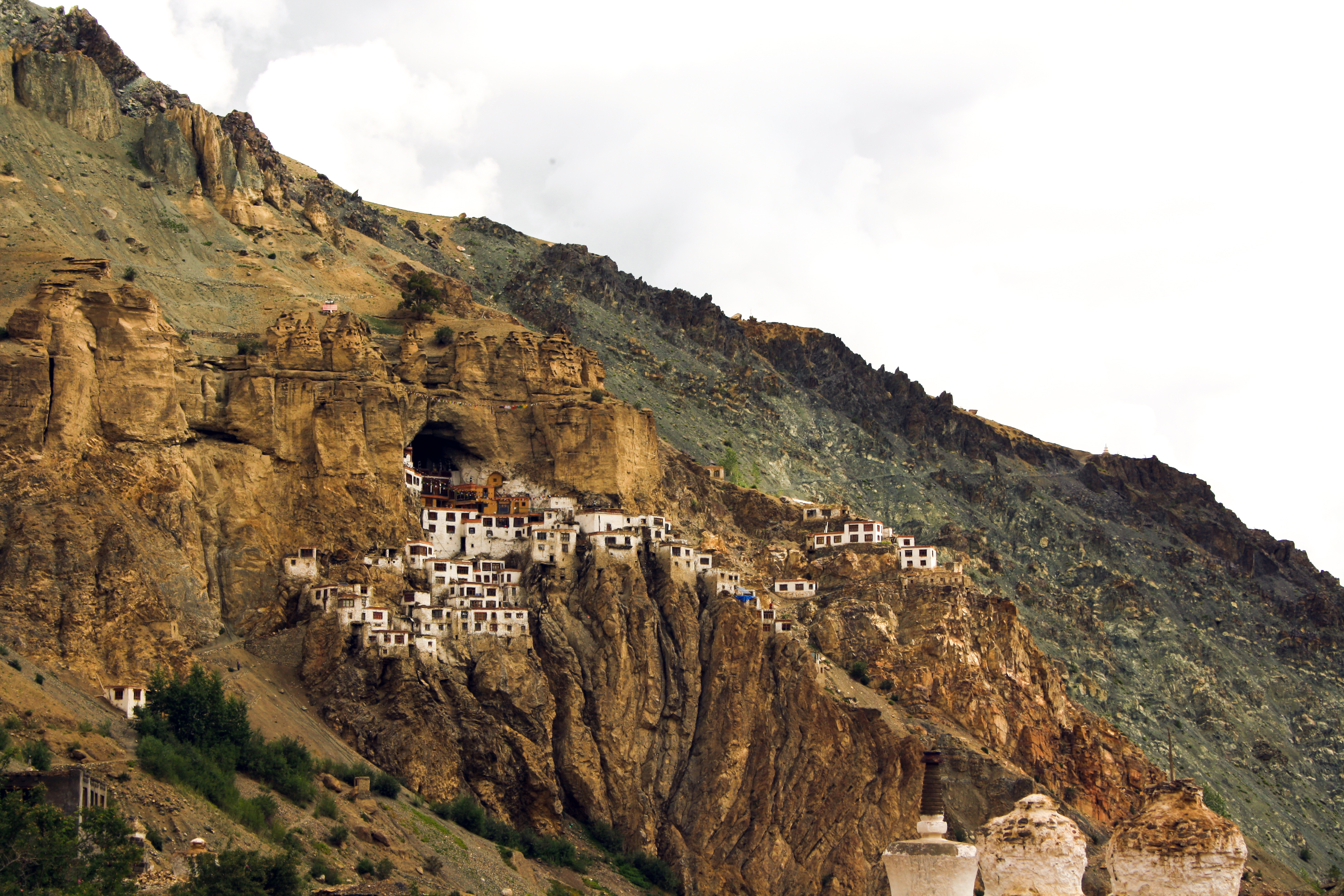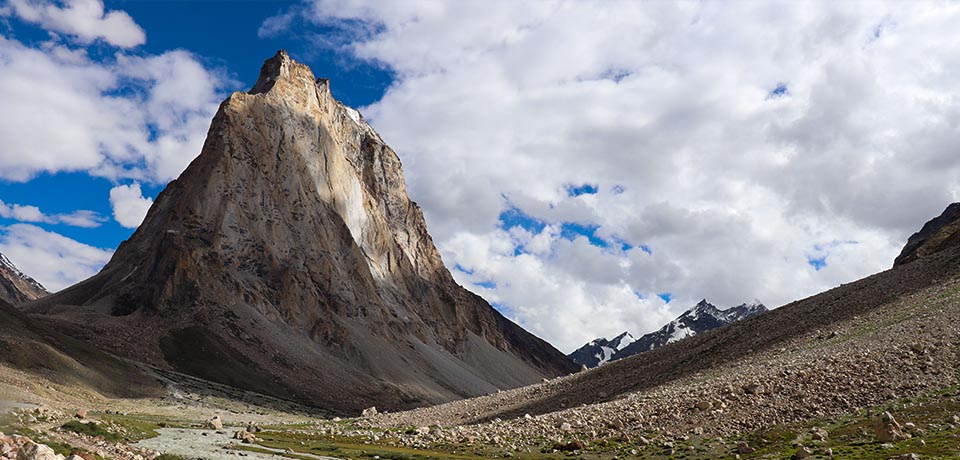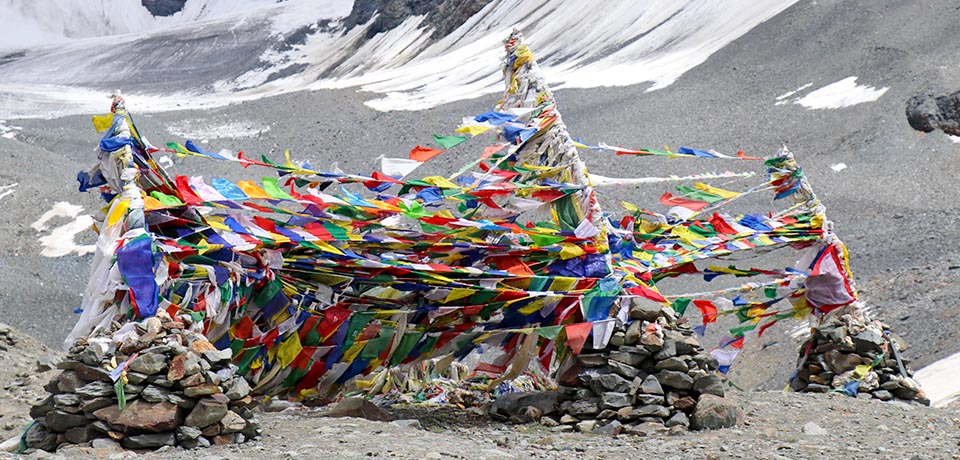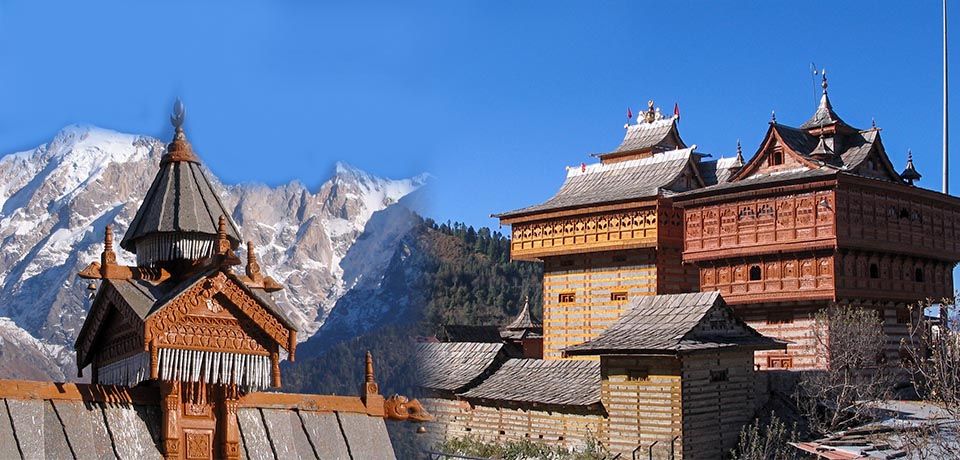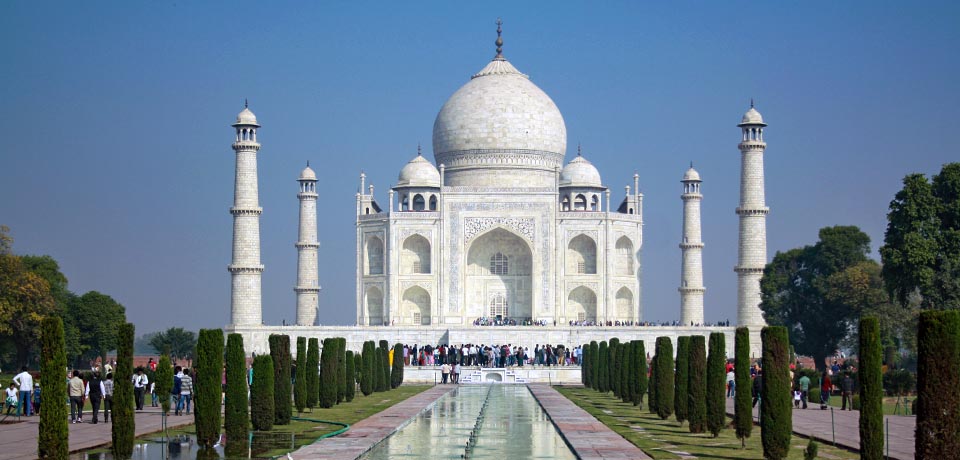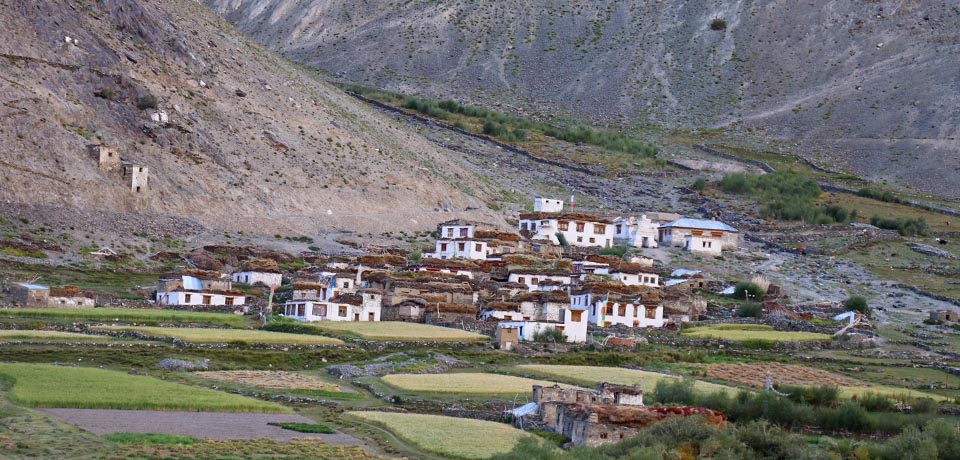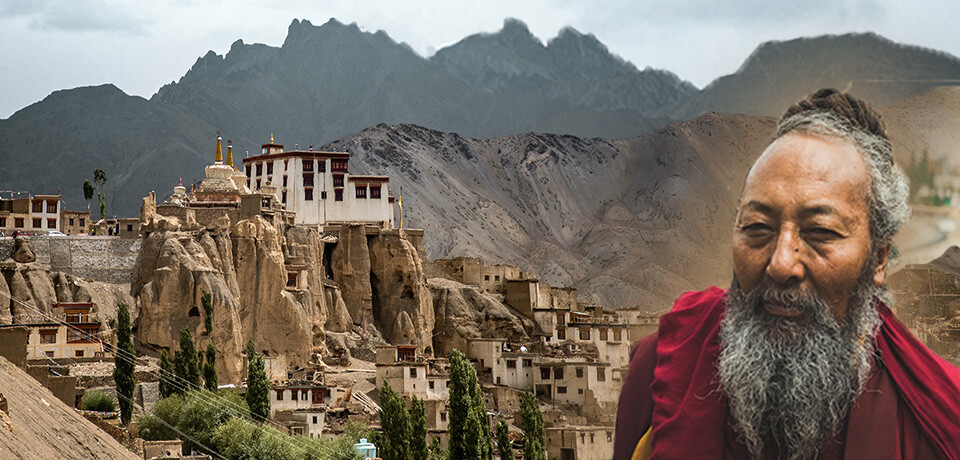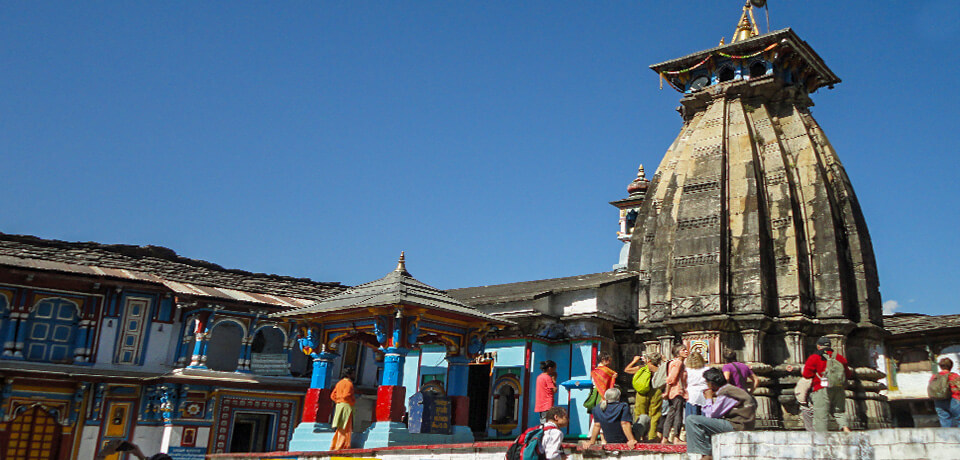Lost Horizon of Himalayan: Kinnaur - Kashmir
Diverse Culture and landscapeThis trip allows you to explore diverse tribes, ethnical culture, landscape of rural valleys located in lap of Himalaya. A spectacular road leads from Simla to the Gorge of Satluj River to the semi desert valley of Kinnaur dominated by mighty Kinner Kailash. Arid valley of Spiti knowns as Little Tibet due to its culture and geographic similarity with Tibet. Lahoul valley is again semi desert region known for its production of Potato and vegetable gives the way to recently open valley of Zanskar. Here onward follow the epic trekking route (Now transformed to the motor able road) of grand traverse of Zanskar amidst the valley.
It allows explore the less frequented villages and Buddhist monasteries located deep in the isolated locations of Indian Himalaya that remains ideal location for meditation to the monks.
Exit of Zanskar will follow scenic Suru valley where stand the highest peaks of Zanskar range of Himalaya, continue to Kashmir, will enchant you with its Mughal Gardens, its mosques, Temple and the magical landscapes of Dal Lake where sail the traditional Shikara. It is like “the paradise on earth” which travellers dream to visit once in lifetime. Journey to India is not complete if you did not visit the seventh wonder of the world “The Taj Mahal”.
During this trip, you will explore diverse landscape, culture heritage, different religions, stunning scenery, and arduous road and will meet cheerful people. All those elements bewitch the traveller’s heart and make this epic journey your lifetime memory.
Day 1: Arrival at Dehli by evening or night.
Day 2: Dehli – Chandigarh –Simla. 2100m. 114 kms. 4h
Day 3: Simla to Sarahan (1920m) 190 km.
Day 4: Sarahan to Chhitkul and Sangla (3450m) 140 kms.
Day 5: Sangla to Recongpeo Kalpa (2290mtrs ) 38kms. (Formalities to issue Inner line permit)
Day 6: Around Kalpa:
Day 7: Recongpeo to Tabo via Nako (3050m) 167 km, 7 hrs
Day 8: Tabo to Kaza (3600m) 60 kms. Via Dhankar and Lalung monasteries.
Day 9: Explore higher and rural part of Spiti: Langza- Hikkim- Kaumic and Kye.
Day 10: Kaza- Jispa (3550m) via Kibber 4200m- over Kunzum pass (4550m) 170 kms. 7h
Day 11: Jispa- Purani (3900m) over Shigola (5090m) 75kms. 5/6 h
Day 12: Walk to Phucktal gompa back to Purni -3h trek. Drive to Padum 3650m 50 kms
Day 13: Padum-Karsha -Tongdey- Zangala. 45 kms. Day excursion
Day 14: Padum – Kargil (3700 m over Pensila (4400 m) Rangdum (3600 m) 220 kms. 8h.
Day 15: Kargil- Srinaggar (1585m) over Zozila (3528m) 202 kms. 7h.
Day 16: Srinagar, Shankracharaya temple, mosque, old city
Day 17: Srinagar- Delhi then drive to Agra 220 km, 3h30 drive
Day 18: Agra-Delhi and Departure
Day 1: Arrival at Dehli
Arrive Delhi by evening, Reception at the airport, transfer to the hotel, night hotel.
Day 2: Arrival at Dehli – Chandigarh –Simla. 2100m. 114 kms. 4h Kalka Shatabdi -12011 -Dep. Delhi 7.40 Arri. Chandigarh- 11.05 am early morning, departure by train to Chandigarh, a modern city of India which is designed by Le Corbusier (a Swiss-French Architecture). Visit the extraordinary Rock Garden, later drive to Shimla, Lunch en route. Simla Once the summer capital of British Raj. Presently is the state capital of Himachal Pradesh and one of known hill station of India. Evening stroll in town to mingle with Indian folk and feel the nostalgia of Victorian era. Night in hotel.
Day 3: Simla to Sarahan (1920m) 190 km.
After early breakfast visit the temple of Jhaku hill dedicated to the Monkey God Hanuman. Advance study hall and drive via Kufri, Narkandha and descend to the Rampur erstwhile Himalayan kingdom of Rampur Busheher. Continue to Sarahan the summer capital of the Rampur Busheher. Visit 1500 years old temple of Bhima Kali, from where one gets a magnificent view of the Shir Khand peaks. Night in hotel.
Day 4: Sarahan to Chhitkul and Sangla (3450m) 140 kms.
Leave for Sangla also called Baspa Valley. The most beautiful valley of Kinnaur dominated by Kamru village. Visit Chitkul villages located on Indo- Tibet border of and Rackchham with typical Kinnauri architecture. Kamru fort once capital of the Bushehar principality, magnificent 7 storied building is an example of the local architecture where access to inner sanctum is not allowed. Night in hotel.
Day 5: Sangla to Recongpeo Kalpa (2290mtrs) 38kms. (Formalities to issue Inner line permit)
Leave to Recongpeo the distt. Headquarter of Kinnaur. Here you will visit to the subdivision magistrate office to complete the administrative formalities to issue the Inner line permit to cross the area located between Indo – Tibet Border. Drive to Kalpa from here the majesty of the Kinner Kailash Mountain is in direct vision. This is regarded as one of the mythical abodes of Lord Shiva. Visit temple of local deity and typical village, take a short walk through village. Night in hotel.
Day 6: Around Kalpa
Visit some of authentic villages of the region, Kothi and its temple dedicated to the goddess Devi Chanadika, Roghi (2700m) surrounding is dotted by the apple trees, people living here are simple, one can witness their ethnicity and preserved traditions when strolling through the village. Walk to Chini village where Hindu and Buddhist cultures mingle harmoniously, visit the small monastery of Hu-Bu-Lan-Ka. Night in hotel.
Day 7: Recongpeo to Tabo via Nako (3050m) 167 km, 7 hrs.
As we enter the restricted area near Indo-Tibet border, where one needs to have inner line permit and passport will be checked at check post at Jhangi. Drive towards the Spiti via Khab where Satluj River joins the Spiti River. Nako, the most charming village offers a magnificent view around. To the north of the village is the monastic complex belonging to the Drugpa order. Another check posts is at Sumdo. Driving through several villages reached we reach at Tabo. Tabo monastery has been founded in 996 A.D. often called the Ajanta of Himalayas. In Trans Himalayas Budhisim Tabo sanctity is next only to Tibet’s Tholing gompa. Night in Camp.
Day 8: Tabo to Kaza (3600m) 60 kms. Via Dhankar- Lalung.
Morning visit Tabo monastery house the exquisite mural painting and frescos. It possible one can participate the morning Prayer ceremony. After visit leave to Dhankar village, once the capital of erstwhile kingdom of Spiti, visit monastery and the most incredibly situated gompa perched high on the barren rocky mountain slopes. The sixth century Dhankar Gompa, though not well preserved still has some magnificent original Thankas and statues tucked away in dark rooms. Further to Lalung village located deep in the Lingthi valley. Lalung, literally means 'land of the gods, monastery containing stucco images and Thankas, is founded by the great Tibetan Buddhist Lotswa “ translator” the Rinchen Zangpo and belongs to the Ge-lug-pa (Gelugpa ) order of Tibetan Budhism, Evening reached Kaza. Explore the tiny town once important center for the bartered trade between India and Tibet. Night in hotel.
Day 9: Explore higher and rural part of Spiti: Langza- Hikkim- Kaumic and Kye.
After early breakfast drive to Langza (4100m), a bowl shaped villages located on the foot of mount Cahu Chau kang Nilda peak also locally known as princess mountain on which the sun & moon shine. 'Here Fossil can be collect in its outskirts for which Spiti is known as live museum. However, millions of years ago, Spiti submerged under the Tethys Sea, hence the remnants of its geological past are witnessed. Visit rustic village of Hikkim built of mud bricks as most of the Tibetan traditional houses, Village is known for one of the highest post office in the world. Bit further is scenic Kaumic village where locate one of the highest monastery of the world. Entire region is dominated by the high mountain range is holding stunning view of Himalaya. Back to Kaza. Afternoon drive to further to scenic Kye Gompa perched high on the hill, you will have opportunity to meet the monks. Monastery houses precious Thankas and mural paintings are remarkable. Night in hotel.
Day 10: Kaza- Jispa (3550m) via Kibber 4200m- over Kunzum pass (4550m) 170 kms. 7h
Leave after early breakfast. Uphill drive to kibber village with its few modern houses, Right place to admire the beauty of desert landscape. Kibber has its charismatic look due to its fortified structure. After a while, you will join ancient trade route that linked between India and Tibet and bit further you will reach at the famous ground called La Darcha where once barter trade festival used to hold between the merchants from both the country India and Tibet. A scenic road leads through several villages of Spiti valley over Kunzum pass (4550 m.) offers extensive view of the snowcapped mountains. Temple located at pass is dedicated to the Goddess Kunzum adorned by prayer flags, pay homage to the goddess. Continue driving through alpine Chandra valley under beneath of sheer mountains to join the Lahoul valley, known for production of Vegetable and potato. Night in hotel/ Fix camp.
Day 11: Jispa- Purani (3900m) over Shigola (5090m) 75kms. 5/6 h
The real over land adventure start here onward on the ancient epic trekking route from Darcha to Lamayuru, the only way possible to get in to the isolated Zanskar valley was by trekking, now the newly built road (trail at the places) opens the access to every seeker of the new horizons. Road wind through last inhabited villages of Lahoul “Rarik and Chhika“ snake curved road brings you to the top of mighty Shigola pass( 5090m) which is the gate way between Lahoul (Himachal) and Zanskar ( Ladakh). It’s worth to have short stop on the pass to appreciate the scenery of Snowy peaks. Zing-Zag descend to the valley, follow the Kargyak Chhu underneath of legendary Gomparangjum peak stand high as spiritual sentinel of the valley. You may encounter the herds of Yaks and marmots paying hide and seek. Kargyak the first village of valley is reached. Take a short walk and continue your drive till Purni. Night in camp/ home stay.
Day 12: Walk to Phuktal gompa back to Purni -3h trek.
Drive to Padum 3650m 50 kms To explore the exclusive site there required some extra efforts. One and half hours of walk (one way) at the place is flat, paved to up and down and cliffy. Follow the opposite flow of Tserap River. After crossing the bridge, you will be amazed when appears an incredible site at the distance, housed in the sheer cliffy cave right above the river below is the astonishing Phuktal Gompa. Phuktal Monastery: Belongs to the tradition of the Gelugpa order of Tibetan Buddhism, located strategically high above the Lugnak River in the remote valley of Zanskar range of Himalaya in north India. It is reached by walk of 1h30 / 2h which goes through scenic gorge from newly opened road-heard. The Phuktal Gompa owes its legacy to powerful scholars who resided in the cave, and has been a idyllic place for retreat, meditation, learning and teaching. Around 2500 years ago It is believed to be visited by translators, scholar, sages and monks. Now days the monastery is home to around 70 monks, it house a temple, library of sacred text, prayer room and have the teaching facility. There is a traditional Tibetan physician (Amchi) who provide natural medicine to the monks and villagers. One can meet the monks who may be busy in their daily routine schedule. Back to Purni, night in same place. After Lunch Follow the Tserap River, villages Surley and Pipula remain opposite side. On the way stop at Bardan monastery belong to the Druk Kagyupa is famous for its prayer wheel and grand statue of Budha. Reach Padum is administrative headquarter of Zanskar sub-division. Night in hotel/ guesthouse.
Day 13: Padum-Karsha -Tongdey- Zangala. 45 kms.
Day excursion Leave to Karsha, stunningly located above Karsha village is very much picturesque. It belongs to gelugpa order (yellow hate) of Tibetan Buddhism, it was founded by the translator, Phagspa Shesra. Monastery house wall paintings, Statue of Avaloketeshwara and many more statues, where resides around 40 monks who perform the prayers and other activities. After lunch leave to Stongdey. Located high above the village on the cliff. Provide the stunning beauty of its surrounding mountains and the valley where Zanskar river born after immersion of Doada and Tserap rivers and flows in middle throughout. Eleventh century monastery belongs to Gelukpa order is the second largest of monastic institution. Around 6o Lamas reside here. Continue to Zangala, the ancient capital of Zanskar kingdom, Fort in ruin is still visited is the architectural example of the valley, located strategically on the rocky outcrop high above to have the village in clear view. Stroll in the village to admire the local rustic houses and to encounter the villages. A Nunnery can be visited which is sub to the permission of the head Nun. Back to Padum, night in hotel / guest house.
Day 14: Padum – Kargil (3700 m over Pensila (4400 m) Rangdum (3600 m) 220 kms. 7-8h.
Leave toward west following the Doada River, on the way visit Saini Gompa, bélongs to the Drukpa Kargyu school of Tibetan Buddhism and is the only one of this order in Zanskar which has nuns. Traverse Zanskar valley over Pensila pas (4400 m) which gives a spectacular view on the Darung-drung glacier and the whole mountains of Zanskar range. Descend to Rangdum, on the way take a short visit to the monastery of Rangdum. Traverse beautiful plain where found abundant of Edelweiss. Continue following the beautiful Suru valley, Shafat glacier remain opposite of road which is spread till the river bank. Valley is dominated by magnificent Nun-Kun the highest peaks of Zanskarr range. Drive through the fertile valley across several villages till Kargil, Night in hotel.
Day 15: Kargil- Srinaggar (1585m) over Zaozila (3528m) 202 kms. 7h.
Scenic drive through the Suru valley. You will take the impressive one-way road between Drass and Sonamarg. Continuation to Zozila, a major pass in the great Himalayan range through which the Leh-Srinagar Road passes. Gradually the landscape become less arid and more wooded. Descent towards Sonamarg, literally means "the golden meadow" located in one of the most beautiful valleys in the world “the Kashmir Valley” The city of Srinagar is founded in the 3rd century B.C. by Emperor Ashoka, Srinagar grew up on either side of the Jhelum River in the heart of the Kashmir Valley. Arriving in Srinagar, you will be taken to your "House Boat" (floating house built all around Dal Lake. By evening you can take a very pleasant "Shikara" (wooden boat typical of the region) ride on Dal Lake in order to explore the life of local peoples inhabited around the lake on the strips of land which is served as kitchen garden as well. Night in a houseboat.
Day 16: Srinagar visit
Shankracharaya temple, mosque, old city Among all the wonders of Srinagar, you will visit the Floating Market (early morning) where locals sell their fresh products on board their Shikara. After breakfast you will traverse the lake by Shikara (small traditional decorated boat) to go up to the temple of Shankracharaya, dedicated to the Lord Shiva which dominates the city of Srinagar. There is also the Hazrat Bal monument which houses the sacred relic of the Prophet, as well as the oldest and largest mosques in Kashmir. Like the Shah Hamdan Masjid where travellers are welcomed in the mosque, the great shrine being reserved for practitioners. Night in a floating house. Afternoon visit the old town of Srinagar and its medieval charm and its view point. Photographers will appreciate the labyrinthine road and its bustling bazaar. If time allows take a evening stroll in one of the Mughal Garden located between the lake and the mountain ranges. Three gardens Chesmashahi, Nishat and Shalimar symbolize the concept of the earthly paradise of the Mughal emperors.
Day 17: Srinagar- Delhi then drive to Agra 220 km, 3h30 drive
From Srinaggar, morning flight to Delhi, meet and greet at the airport where a driver will meet you to accompany to Agra. Visit Mahal, one of the most famous monuments of the world listed as 7thwonder of the world, built in the seventeenth century by the Emperor Shah Jahan as a token of eternal love. Agra is home to number of crafts man, known for Marble replica are best souvenir to take back to home among many other items as of leather and embroidery textile. Night at the hotel.
Day 18: Agra-Delhi and Departure.
In Agra, morning you will visit the Red fort built in 16th century by red sand stone, once the capital of Mughal Empire, This fort was served as their résidence and set an exemple of historic blend of Hindu and Islamic style of architecture. Drive to Delhi. If time allows take glimpse on India gate and president house or spend some time to buy the souvenir. By evening transfer to airport to board the flight to your onward destination. No hotel in Delhi. Note: Please be sure that your insurance covers your all expenses in high altitude as of ground or air rescue during your expedition in case of accident, altitude sickness if helicopter required: We request you to provide Himalayan Frontiers the Insurance number, policy number, 24 hours emergency contact of insurance, persons in your family to be contacted if need be.
COST INCLUDE
Pick up & drop from airports.
All sightseeing as mentioned in program Vehicle Toyota Innova, Scorpio, Zylo, Tata sumo, or Tempo-traveller
Breakfast and dinner include
Hotel 3* in city, guest houses, fix camp or home stay at Prune, House boat in Srinaggar Twin or Double sharing room. In case of home stay at Purne (double or triple sharing room) 3
English speaking guide.
GST 5%
COST EXCLUDE
Any airfares
Lunch during entire trip
Monument fee
Beverages
Travel insurance / Medical expenses
Early check-in or late checkout at hotels
Tips to guide/cook, porters, drivers and in hotels / restaurant.
Video and still camera fee where applicable
Any expenses if occur due to unforeseen circumstances such as delay or cancelation of flights, weather condition, land slide, political unrest, sickness or any other circumstances beyond our control
Refund to unused services
Single room surcharge
Refund to unused services

Lost Horizon of Himalayan: Kinnaur - Kashmir
India ModerateDuration : 18 days
Region : Himachal- Zanskar- Kashmir-Agra
Season: Mid-June to 15 Oct.
Highlights
Modern planned city and rock garden of Chandigarh
Diverse culture heritage of Kinnaur-Spiti- Zanskar and Kashmir
Ancient Buddhist monasteries, Hindu Temples and mosque
Attending the ritual and interaction with monks and villagers
Remarkable architecture and authentic culture varies from one region to other
Lush green valleys, arid regions and oases.
High altitude meadows where graze the yak and other livestock
Stunning view of snowcapped mountains, glaciers and alpine landscape
Phukatal monastery incredibly hanged high over the Lugnak River is reached by walk.
Shikara ride in Dal Lake, floating market and Mughal garden of Kashmir
Crossing 4 passes, highest amongst all is Shingola pass elevating 5090m.
Taj Mahal, the 7thwonder of the world

